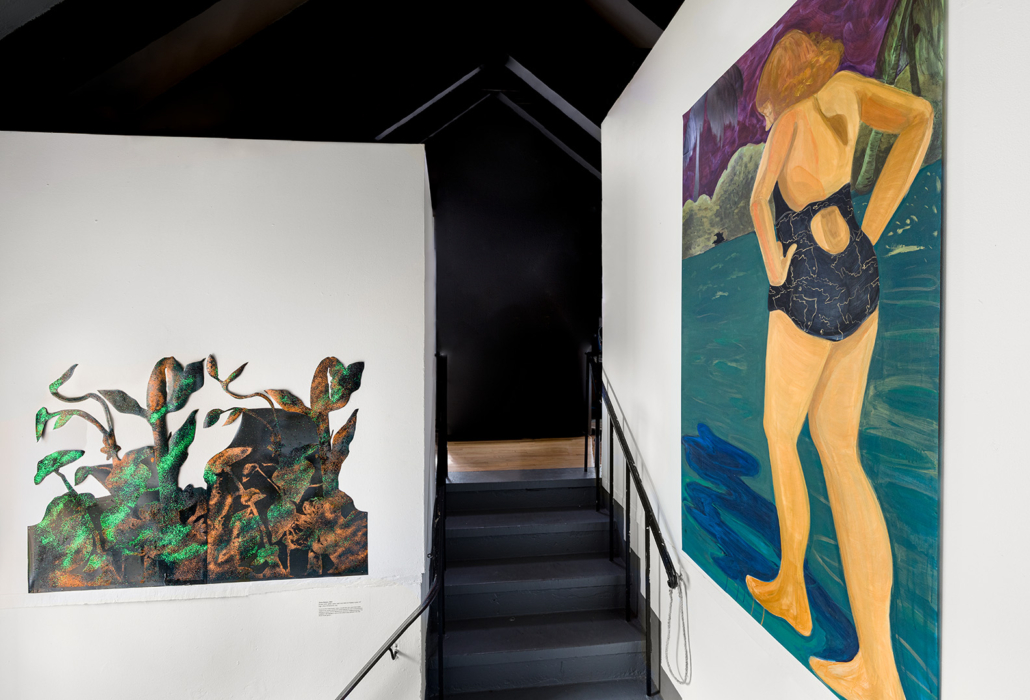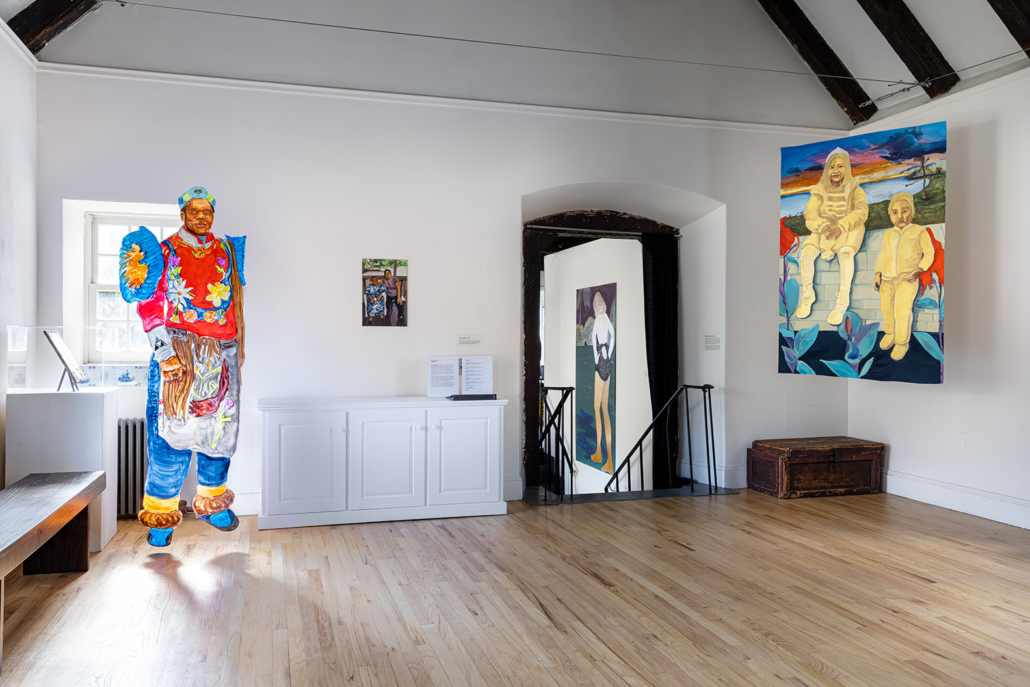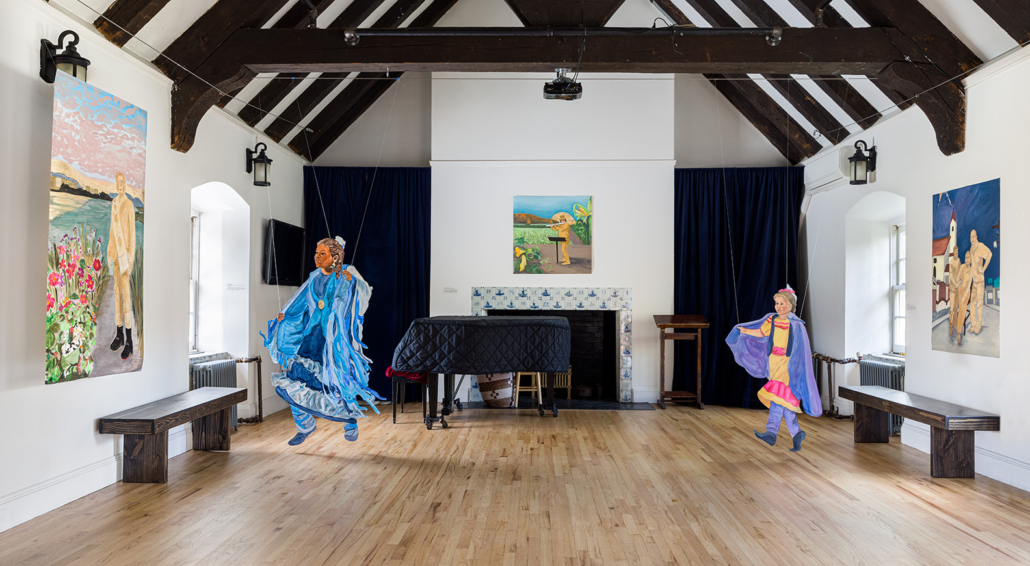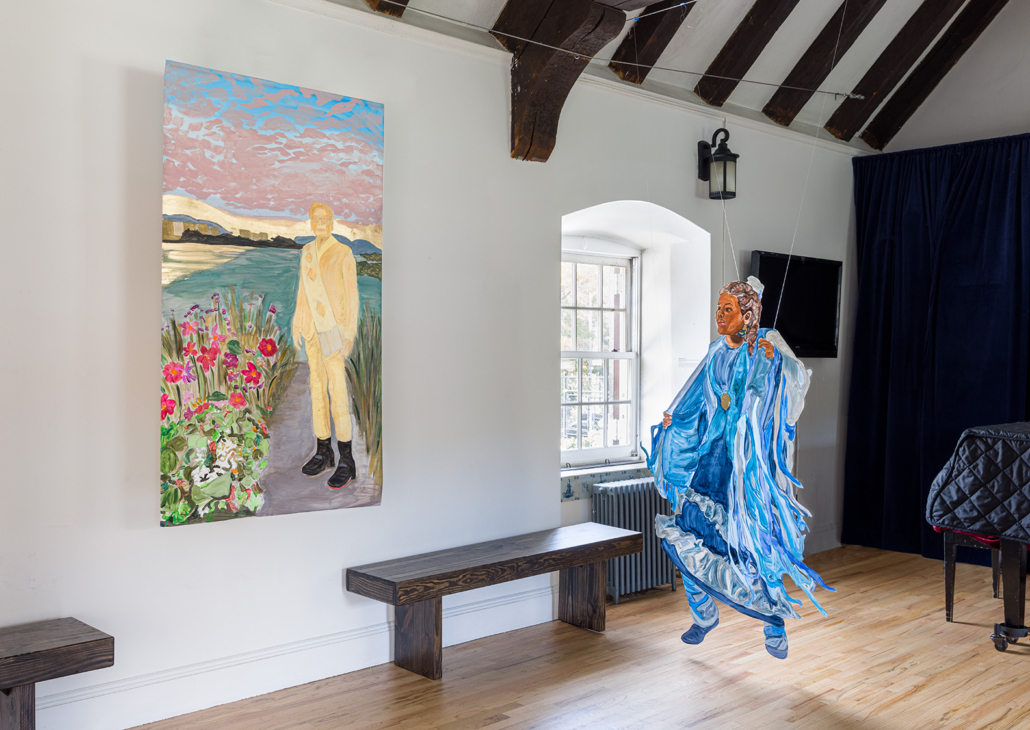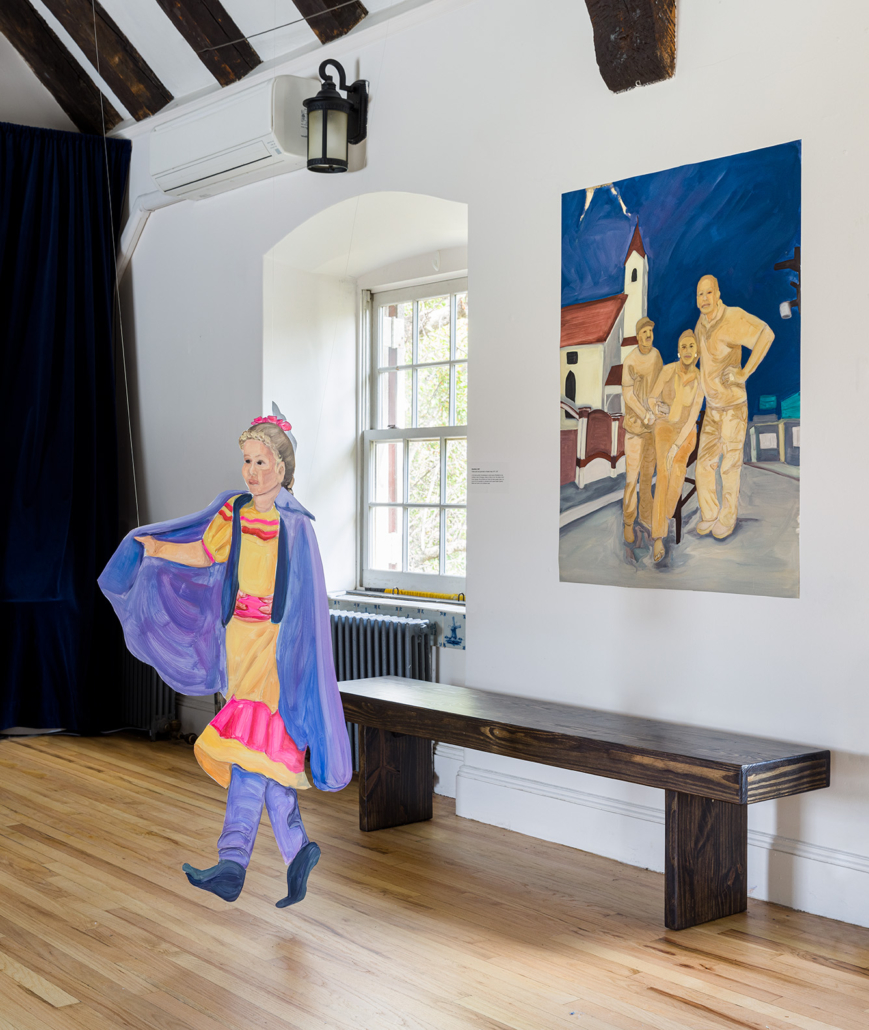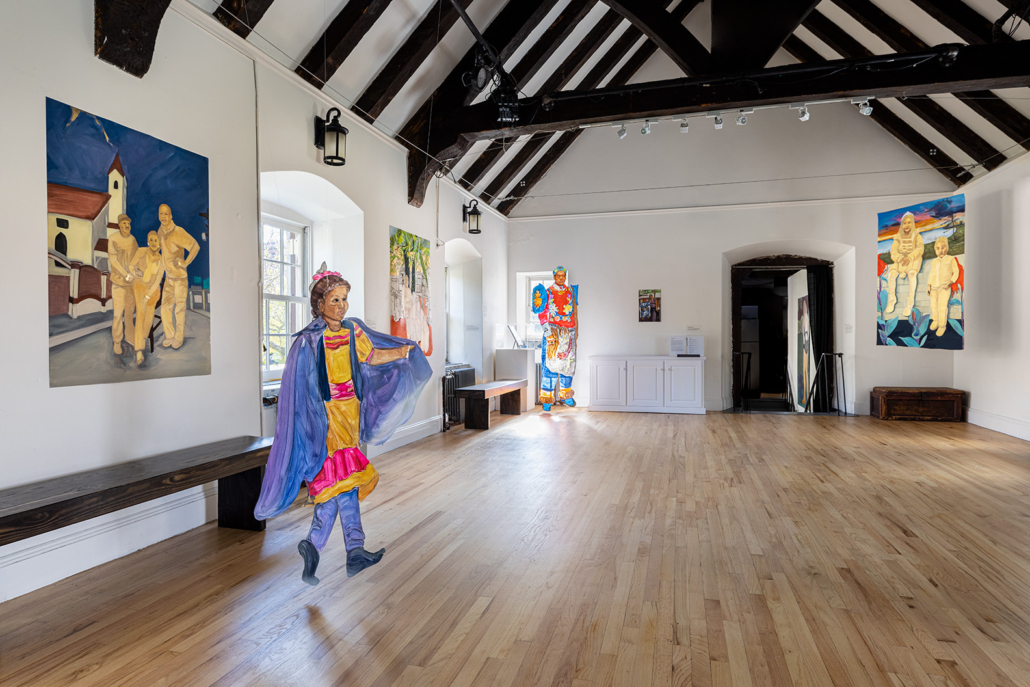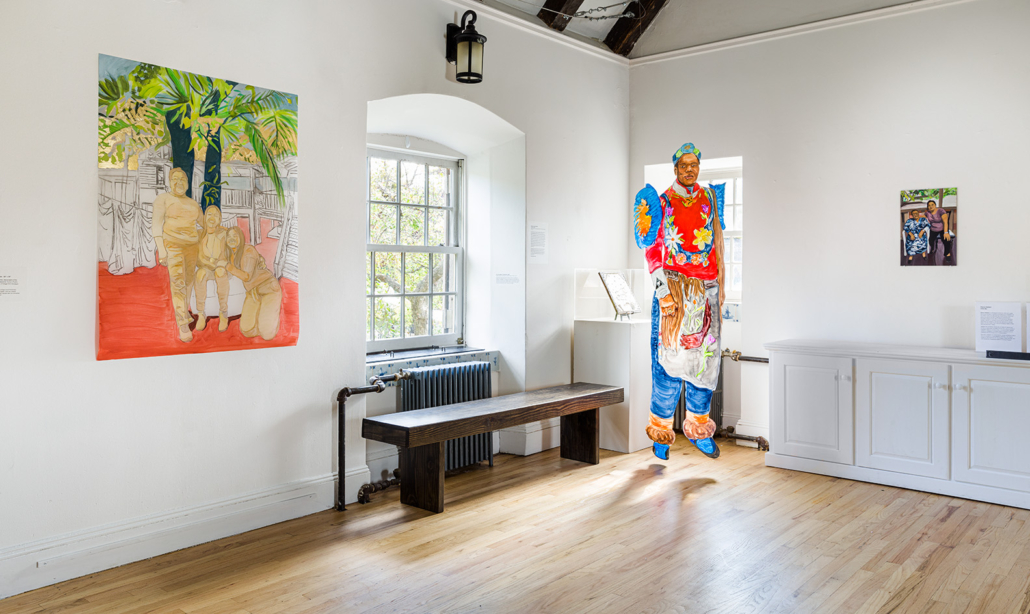This Exhibit is past. Visit our Exhibitions page for information on the current programming.
Descendants
Artwork by Dianne Hebbert
October 16, 2021 – January 30, 2022
Opening Reception October 16, 2021, 1 pm – 3 pm.
Gallery hours Friday-Sunday, Noon – 4 pm beginning October 22, 2021.
This portrait exhibition celebrates people of Latinx and American Indigenous heritage and the continuation of their cultural traditions as a form of resilience.
Enjoy this virtual tour slide show of the exhibition, photographed by Etienne Frossard.
Public Programs:
Join Dianne to make a painted portrait of your loved one, perfect for personalized holiday gift giving. Bring a favorite photo and learn all the steps of the process.
October 24, 4 pm – 6 pm & November 21, 11 am – 1:30 pm. $10 suggested donation.
Sign up here! (Archived link)
Overview:
Descendants is a new body of work by Dianne Hebbert depicting people of Indigenous descent in collaged paradisiacal landscapes. Through larger-than-life representations of real people that claim space, the work celebrates people of Latinx and American Indigenous heritage and the continuation of their cultural traditions as a form of resilience.
About the Artworks:
Portraits include members of the artist’s Nicaraguan Miskito family; youth from the Brooklyn-based Mexican and Latin-American immigrant empowerment organization Mixteca; and descendants of the Lenape tribe that originally inhabited the land surrounding the Old Stone House (OSH). The choice of subject matter was inspired by Hebbert’s past work as a teaching artist with Mixteca and visits to the NYC-based Lenape Center events as well as historic Lenape images. The portraits’ backgrounds consist of collaged images of Caribbean landscapes and reserved Indigenous land in the United States.
Continuing the artist’s ongoing investigation of glorification, migration, and displacement through posture and fashion, this new body of work further pushes experimentation with materials and representation. Inspired by Italian Renaissance, Egyptian and Buddhist art, Hebbert incorporates gold to attribute the highest value and esteem to her figures, creating superlative beings. Site-specific exhibition components include large suspended figures on mylar in the gallery and an outdoor installation featuring traditional Indigenous crops that reference native plants in the OSH garden and continued life, growth and adaptation.
Descendants corresponds with the opening of the OSH’s new interactive exhibit on the Lenape history of the site. OSH is at the crossroads of ancient Lenape paths, adjacent to the historic town of Marechkawick. In the 1640s, the Dutch West India Company began a series of violent confrontations known as Kieft’s War, breaking its agreements with the Lenape. By 1645, the Lenape of Marechkawick agreed to sell their lands in what would become Brooklyn, forcing them west to Staten Island and the Hudson Valley. Today, despite the displacement of its original Lenape residents, New York City still has one of the largest intertribal Indigenous communities in the country.
Descendants is one of a series of exhibits and programs at OSH that provide opportunities for contemporary Indigneous artists to connect a greater awareness of the past to critical conversations about Brooklyn’s future.
About the Artist:
Dianne Hebbert is a Nicaraguan-American artist and curator. She works primarily in painting, printmaking and installation art. As a Miami native she attended New World School of the Arts before she earned her BFA in Painting and Drawing from Purchase College and her MFA in Printmaking from Brooklyn College. Hebbert is a recipient of the Vermont Studio Center Fellowship and residency, and she was selected as a Smack Mellon Hot Pick Artist in 2017 and an Emerging Leader of New York Arts 2016-2017 Fellow.
Hebbert has completed residencies at Trestle Art Space and Constance Saltonstall Foundation for the Arts, and is currently a Chashama Space to Connect artist. In the fall of 2019 Hebbert created an installation at Fordham Plaza in the Bronx, NY for Chashama and the Department of Transportation.
Since 2011 Hebbert has independently curated exhibitions with a focus on diversity for small galleries in Brooklyn, the Virginia Center for Latin American Art, The College of New Rochelle, and most recently for Chashama’s Space to Connect Program. Visit her on Instagram @diannehebbert.
About the Curator:
Katherine Gressel, the Old Stone House & Washington Park’s Contemporary Art Curator, is a New York‐based curator, artist, and writer focused on site‐specific art. She earned her BA in art from Yale and MA in arts administration from Columbia. Katherine’s previous exhibits dealing with such topics as income inequality, urban agriculture, and parks have been recognized by the New York Times, Time Out New York, Hyperallergic, News 12 Brooklyn, and DNAInfo. In addition to organizing eleven major exhibitions to date at the Old Stone House, Katherine has curated for FIGMENT, No Longer Empty, St. Francis College, and Brooklyn Historical Society, and was the 2016 NARS Foundation emerging curator. She was selected for the 2015 Independent Curators International (ICI) Curatorial Intensive in New Orleans. Katherine has written and presented on public and community art issues for Createquity, Americans for the Arts, and Public Art Dialogue, among others. Katherine also served as Programs Manager at Smack Mellon Gallery from 2010-2014, and has worked and consulted for diverse nonprofits.
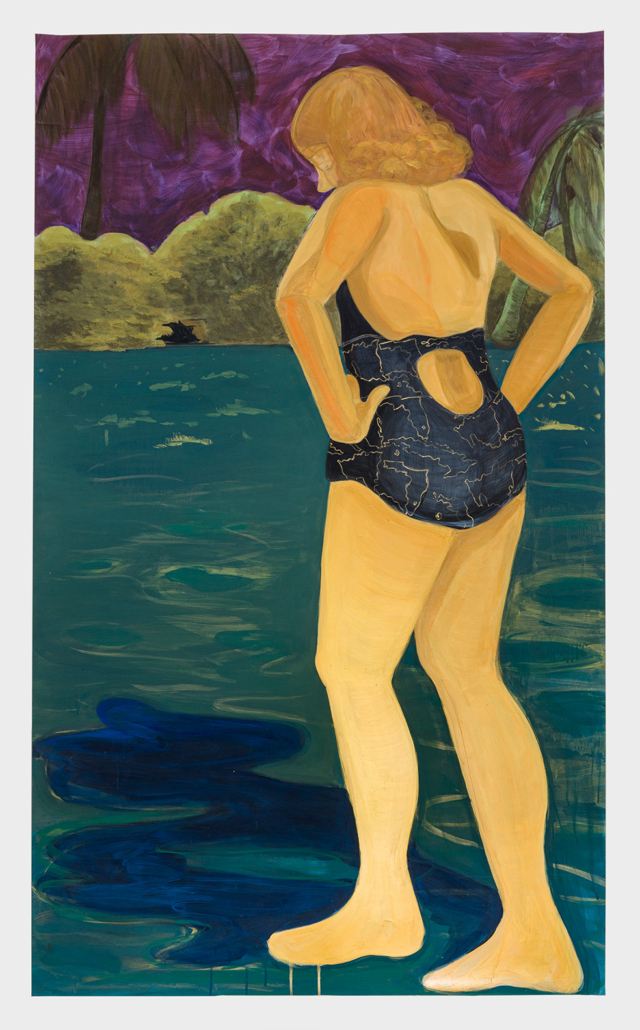
Futuro de Oro (2019)
Flashe paint on frosted mylar, 72” x 42”
In this painting of my niece, the design on the bathing suit is of Florida, Cuba and Nicaragua, representing her specific heritage. The background is of a beach in Florida.
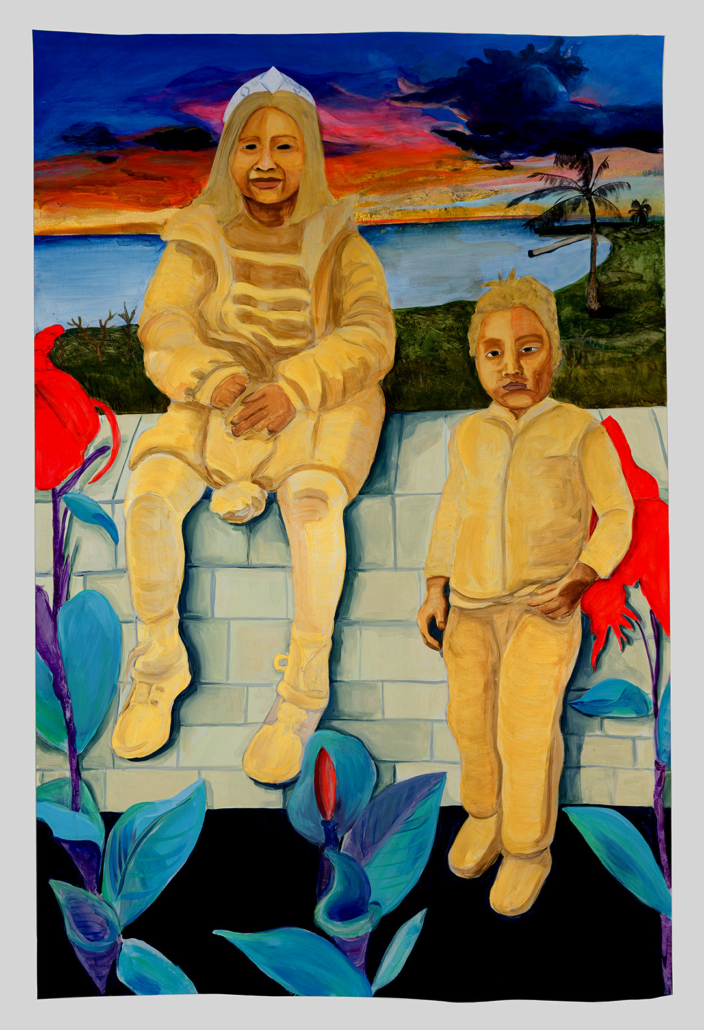
Jóvenes Reales (Young Royals) (2021)
Flashe paint and gold leaf on frosted mylar, 63” x 42”
Jóvenes Reales features two portraits of children I met at the organization Mixteca in Brooklyn, where I painted a mural and taught workshops in collaboration with Chashama. Mixteca offers a variety of programs and services for families in Brooklyn’s growing Mexican and Latin-American immigrant community. I chose to depict these subjects because their age symbolizes hope and the experience of being a new American. Their families migrated to this country with hopes for their future.
The background combines imagery from Corn Island, Nicaragua and the sky is from St. Lucia–symbolic of the similarities and differences between Latin and Caribbean countries, each with its own history and traditions. The flowers are Black Knight Canna Lilies, a plant native to tropical wetlands in North and South America. The plants are easy to care for and add vibrant color to their surrounding environments.
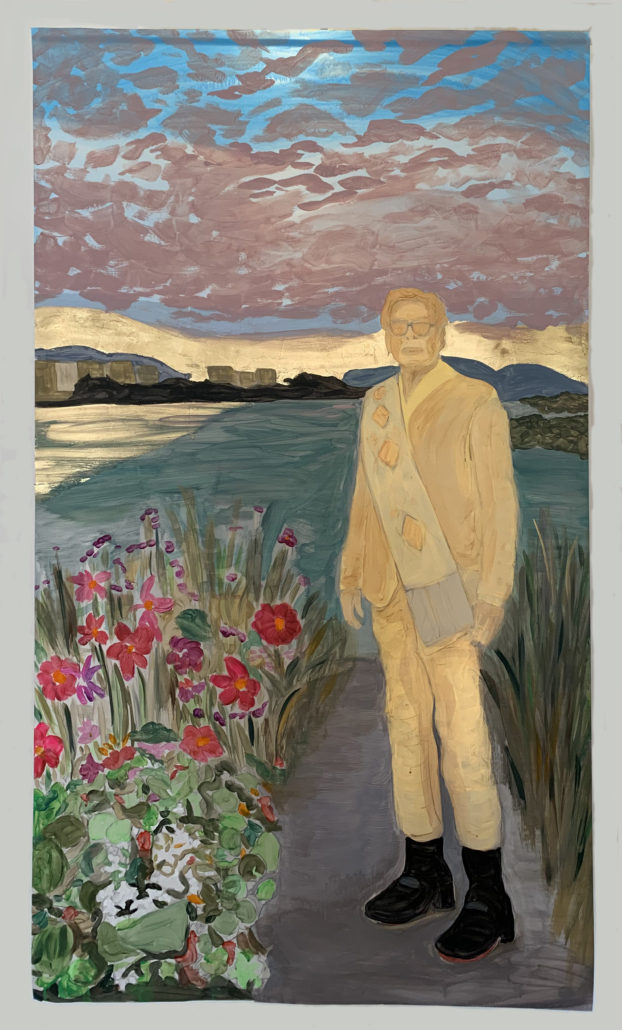
Joe Baker – Lenapehoking (2021)
Flashe paint and gold leaf on frosted mylar, 63” x 36”
Joe Baker is the executive director and co-founder of the Lenape Center and a member of the Delaware Tribe. He is standing in front of Lenapehoking, a term for Lenape land, wearing a traditional sash from the tribe. The shoes are Mayerswing, new Christian Louboutin boots whose design is based on moccasins. The florals are wild flowers, growing freely.
The Lenape Center is a New York City-based organization founded in 2008, dedicated to continuing Lenapehoking through arts, culture and community programming. After forced displacement from what is now New York City as a result of European settler occupation, today’s Lenape diaspora includes members of federally recognized nations in Oklahoma, Wisconsin, and Ontario, Canada.
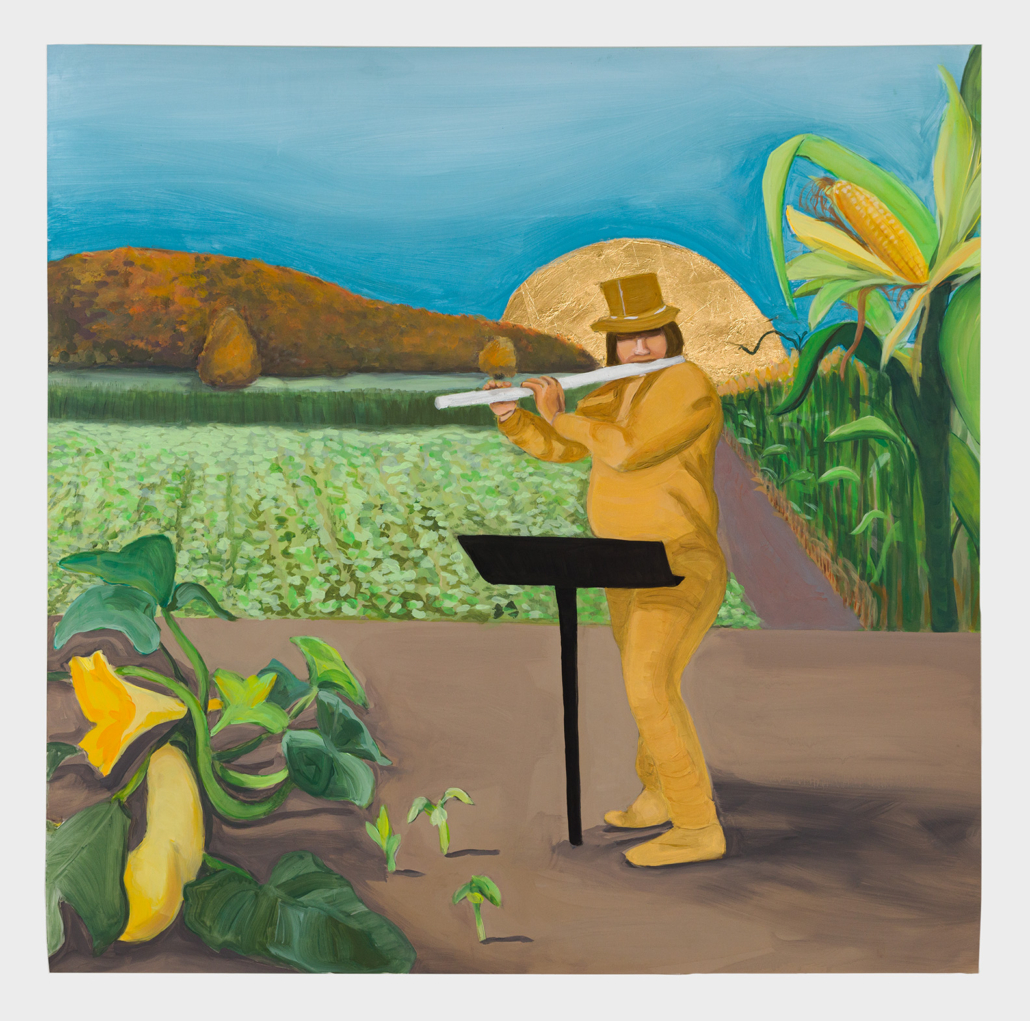
Brent Michael Davids (2021)
Flashe paint and gold leaf on frosted mylar, 36” x 36”
Brent Michael Davids is an award-winning composer and co-director of the Lenape center. He is an enrolled member of the Stockbridge-Munsee Band of the Mohican Nation. The landscape behind him is a combination of the Delaware river, Lenape land and paintings of the “three sisters” crops that were important to the Lenape people: corn, beans and squash.
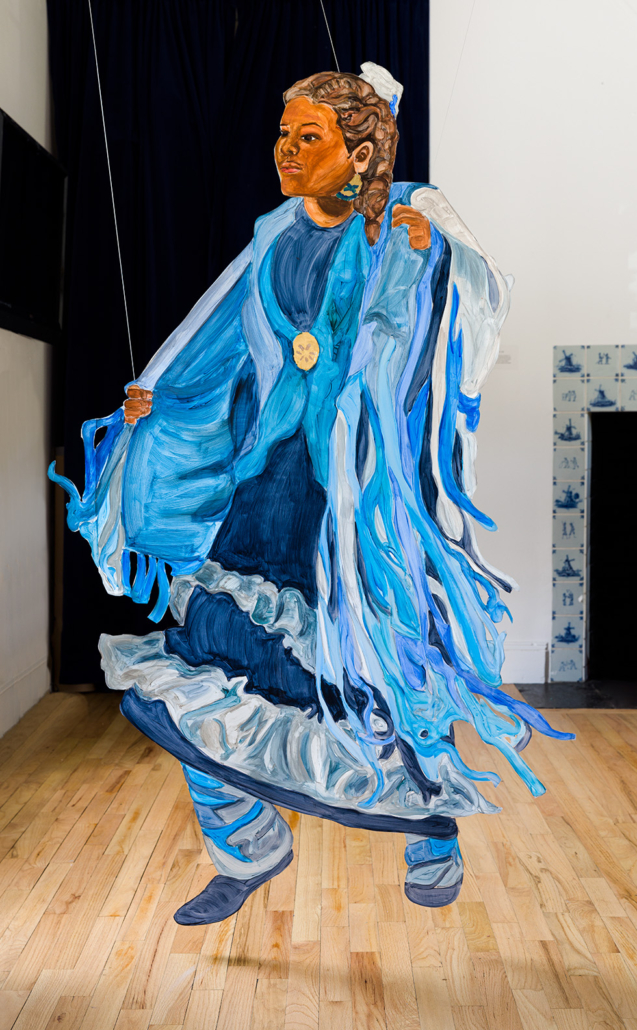
Matrilineal (2021)
Flashe paint and gold leaf on frosted mylar, Figure 1: 65” x 44”
The imagery in this mother and daughter pair, depicted mid dance, combines traditional aboriginal ceremonial costumes from various tribes of different regions of North, Central and South America. Descendants are usually traced by the kinship of the mother’s line.
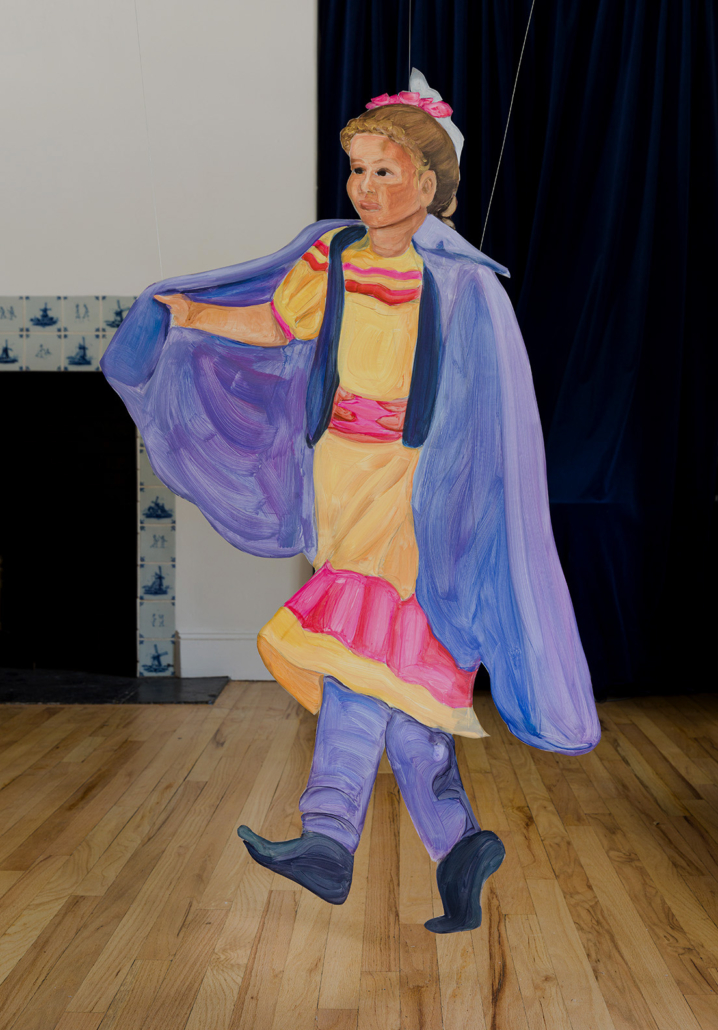
Matrilineal (2021)
Flashe paint and gold leaf on frosted mylar, Figure 2: 55” x 37”
The imagery in this mother and daughter pair, depicted mid dance, combines traditional aboriginal ceremonial costumes from various tribes of different regions of North, Central and South America. Descendants are usually traced by the kinship of the mother’s line.
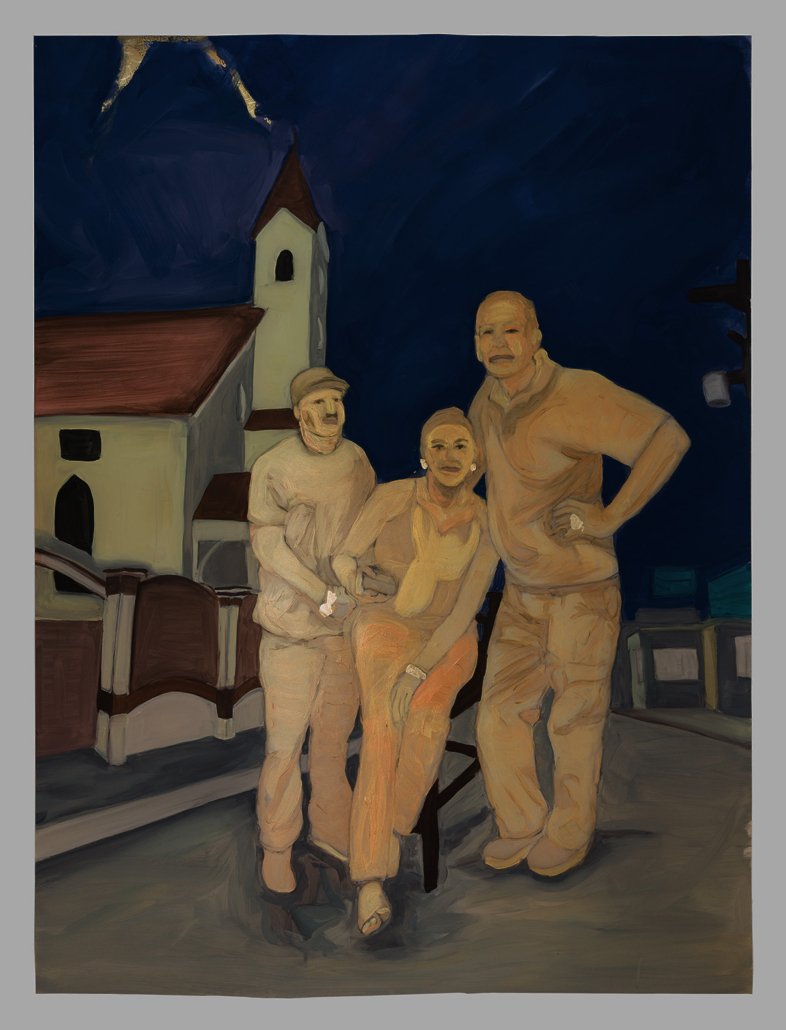
Bluefields (2021)
Flashe paint and gold leaf on frosted mylar, 48” x 36”
In this family portrait, the landscape is a night scene of Bluefields on the Caribbean coast of Nicaragua, where my father is from. My mother is from Puerto Cabezas. We are Miskito and Creole. My father speaks Creole. It is common for the population to understand and/or speak English, Spanish, Miskito and Creole on the Caribbean coast.
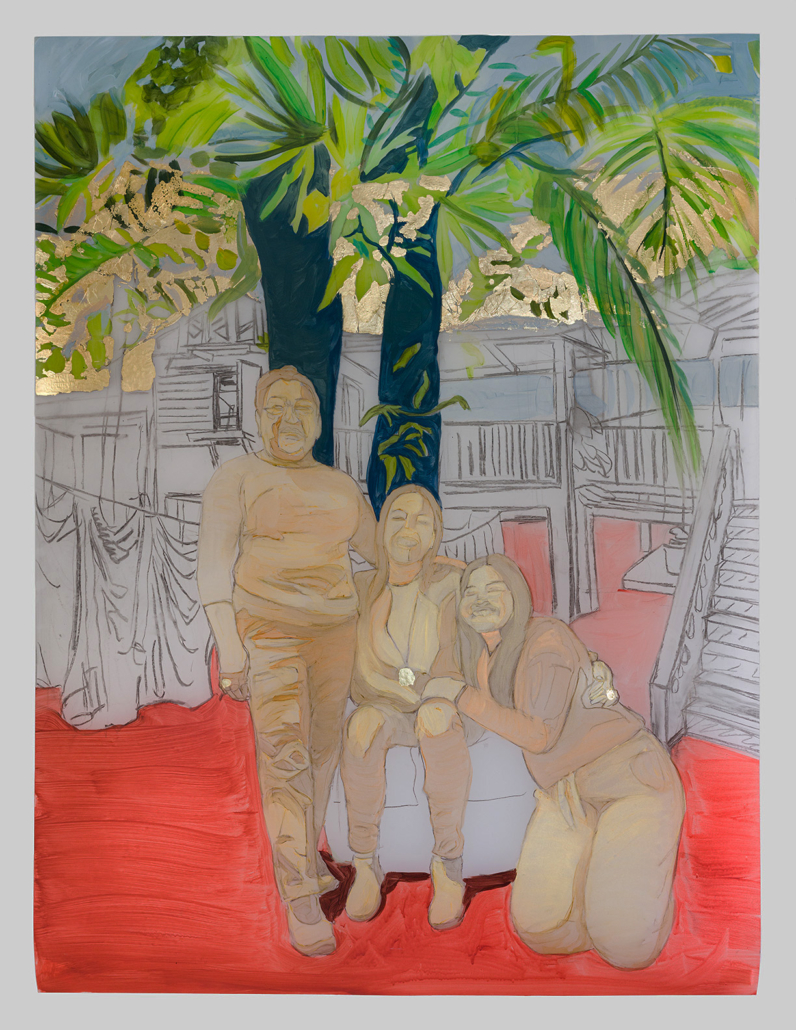
Generaciones de Miskito (2021)
Flashe paint and gold leaf on frosted mylar, 48” x 36”
This portrait shows three generations of my family, descendants of the Miskito people. The background is of my grandparents’ home in Puerto Cabezas, Nicaragua. It includes a combination of foliage from Nicaragua and Miami, Florida, where I also have family.
Miskito are found on the Caribbean coast of Nicaragua and Honduras. Nicaragua was colonized by the Spanish and English, and as a result customs are different from coast to coast. Miskito people own our ancestral land, having been granted independence in 1987.
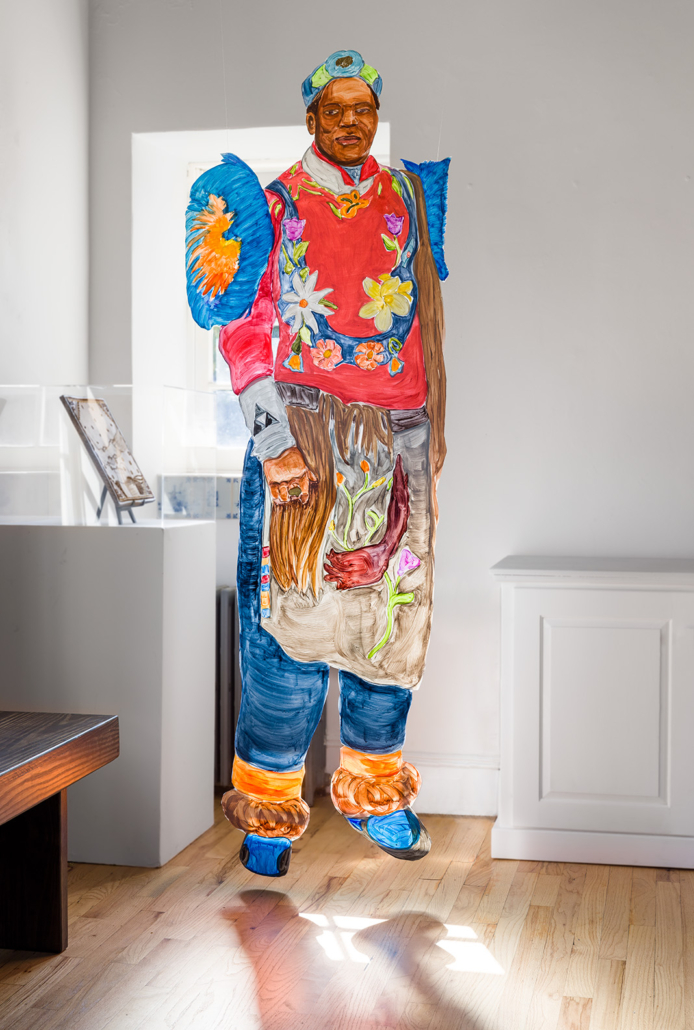
For the Leaders of Resistance (2021)
Flashe paint and gold leaf on frosted mylar, 77.25” x 24.5”
This portrait is based on researched images of Nicarao, an indigenous chieftain who resisted the initial wave of colonizers in the 16th century in Nicaragua. The imagery is combined with traditional aboriginal ceremonial costumes from various tribes of different regions, including North, Central and South America. His cuff includes the triforce symbol or three scales symbol, which symbolizes power, wisdom and courage.
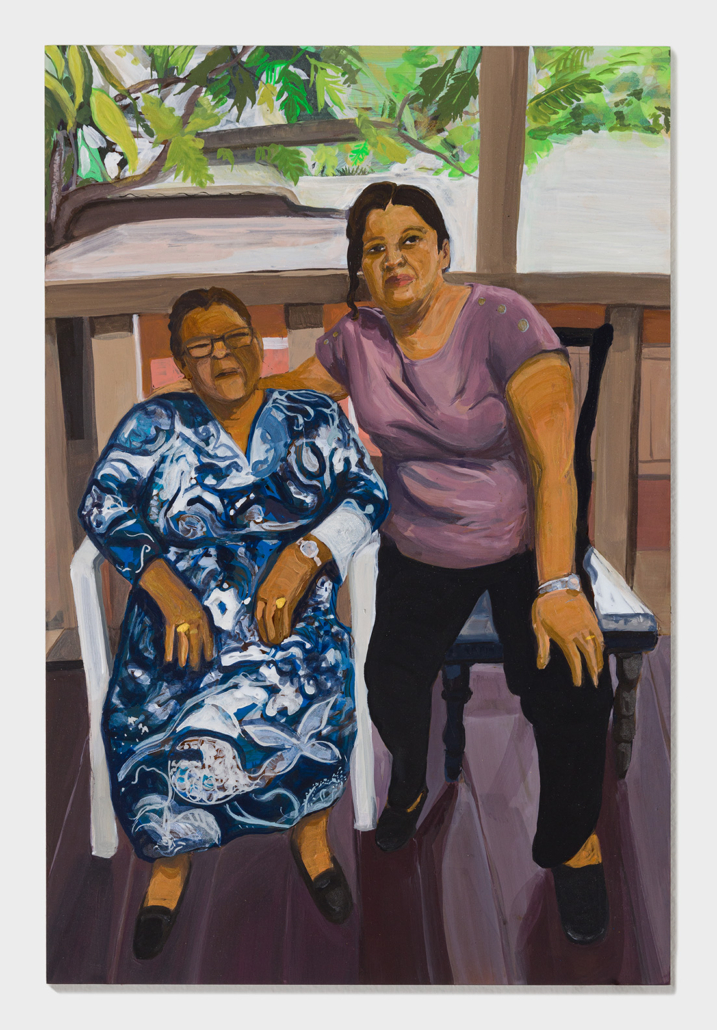
Under the Breadfruit Tree (2021)
Flashe paint on plexi, 18” x 12”
I painted my mother and late grandmother on her porch in Nicaragua, under the breadfruit tree. Originally from Southeast Asia, breadfruit was brought to the West Indies as a food source for slaves. The tree is now grown in Florida, the Caribbean, and from Mexico to Brazil.
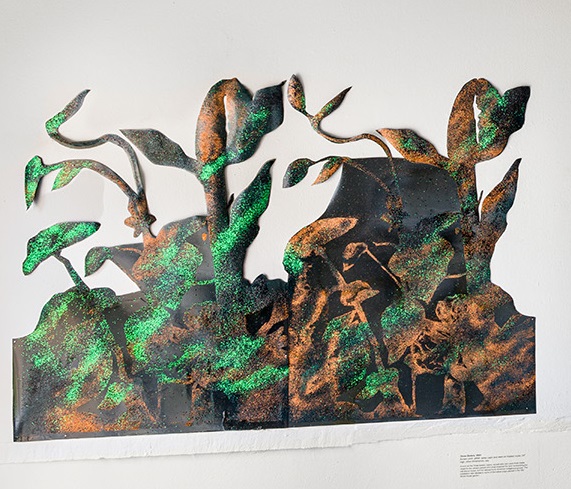
Three Sisters (2021)
Screen print, glitter, spray paint and resin on frosted mylar, 24” high, other dimensions vary
Known as the Three Sisters, beans, squash and corn were three staple crops for the Lenape people who once inhabited the land surrounding the Old Stone House, and for various North American Indigenous groups. The installation also alludes to some of the native crops planted in the Old Stone House garden.
Descendants is made possible by the New York State Council on the Arts with the support of Governor Andrew M. Cuomo and the New York State Legislature, The Shelley & Donald Rubin Foundation, and the New York City Department of Cultural Affairs.

